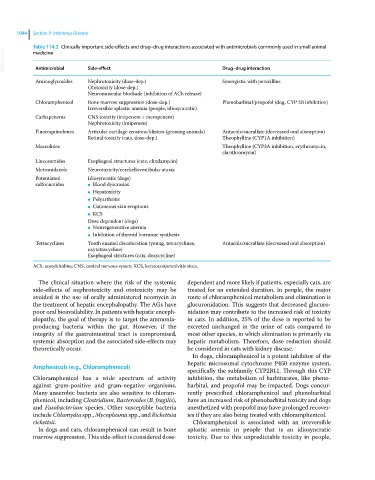Page 1106 - Clinical Small Animal Internal Medicine
P. 1106
1044 Section 9 Infectious Disease
Table 114.2 Clinically important side‐effects and drug–drug interactions associated with antimicrobials commonly used in small animal
VetBooks.ir Antimicrobial Side‐effect Drug–drug interaction
medicine
Aminoglycosides Nephrotoxicity (dose‐dep.) Synergistic with penicillins
Ototoxicity (dose‐dep.)
Neuromuscular blockade (inhibition of ACh release)
Chloramphenicol Bone marrow suppression (dose‐dep.) Phenobarbital/propofol (dog, CYP 2B inhibition)
Irreversible aplastic anemia (people, idiosyncratic)
Carbapenems CNS toxicity (imipenem > meropenem)
Nephrotoxicity (imipenem)
Fluoroquinolones Articular cartilage erosions/blisters (growing animals) Antacids/sucralfate (decreased oral absorption)
Retinal toxicity (cats, dose‐dep.) Theophylline (CYP1A inhibition)
Macrolides Theophylline (CYP3A inhibition, erythromycin,
clarithromycin)
Lincosamides Esophageal structures (cats, clindamycin)
Metronidazole Neurotoxicity/cerebellovestibular ataxia
Potentiated Idiosyncratic (dogs)
sulfonamides ● Blood dyscrasias
● Hepatoxicity
● Polyarthritis
● Cutaneous skin eruptions
● KCS
Dose dependent (dogs)
● Nonregenerative anemia
● Inhibition of thyroid hormone synthesis
Tetracyclines Tooth enamel discoloration (young, tetracyclines, Antacids/sucralfate (decreased oral absorption)
oxytetracycline)
Esophageal strictures (cats, doxycycline)
ACh, acetylcholine; CNS, central nervous sysem; KCS, keratoconjunctivitis sicca.
The clinical situation where the risk of the systemic dependent and more likely if patients, especially cats, are
side‐effects of nephrotoxicity and ototoxicity may be treated for an extended duration. In people, the major
avoided is the use of orally administered neomycin in route of chloramphenicol metabolism and elimination is
the treatment of hepatic encephalopathy. The AGs have glucuronidation. This suggests that decreased glucuro-
poor oral bioavailability. In patients with hepatic enceph- nidation may contribute to the increased risk of toxicity
alopathy, the goal of therapy is to target the ammonia‐ in cats. In addition, 25% of the dose is reported to be
producing bacteria within the gut. However, if the excreted unchanged in the urine of cats compared to
integrity of the gastrointestinal tract is compromised, most other species, in which elimination is primarily via
systemic absorption and the associated side‐effects may hepatic metabolism. Therefore, dose reduction should
theoretically occur. be considered in cats with kidney disease.
In dogs, chloramphenicol is a potent inhibitor of the
hepatic microsomal cytochrome P450 enzyme system,
Amphenicols (e.g., Chloramphenicol)
specifically the subfamily CYP2B11. Through this CYP
Chloramphenicol has a wide spectrum of activity inhibition, the metabolism of barbiturates, like pheno-
against gram‐positive and gram‐negative organisms. barbital, and propofol may be impacted. Dogs concur-
Many anaerobic bacteria are also sensitive to chloram- rently prescribed chloramphenicol and phenobarbital
phenicol, including Clostridium, Bacteroides (B. fragilis), have an increased risk of phenobarbital toxicity and dogs
and Fusobacterium species. Other susceptible bacteria anesthetized with propofol may have prolonged recover-
include Chlamydia spp., Mycoplasma spp., and Rickettsia ies if they are also being treated with chloramphenicol.
rickettsii. Chloramphenicol is associated with an irreversible
In dogs and cats, chloramphenicol can result in bone aplastic anemia in people that is an idiosyncratic
marrow suppression. This side‐effect is considered dose- toxicity. Due to this unpredictable toxicity in people,

